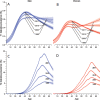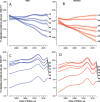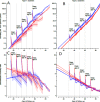Prevalence, incidence and mortality of type 1 and type 2 diabetes in Denmark 1996-2016 - PubMed (original) (raw)
Review
Prevalence, incidence and mortality of type 1 and type 2 diabetes in Denmark 1996-2016
Bendix Carstensen et al. BMJ Open Diabetes Res Care. 2020 May.
Abstract
Introduction: The objective of this study was to give an overview of prevalence, incidence and mortality of type 1 (T1D) and type 2 diabetes (T2D) in Denmark, and their temporal trends.
Research design and methods: We constructed a diabetes register from existing population-based healthcare registers, including a classification of patients as T1D or T2D, with coverage from 1996 to 2016. Using complete population records for Denmark, we derived prevalence, incidence, mortality and standardized mortality ratio (SMR).
Results: The overall prevalence of diabetes at 2016 was 0.5% for T1D and 4.4% for T2D, with annual increases since 1996 of 0.5% for T1D and 5.5% for T2D. Incidence rates of T1D decreased by 3.5% per year, with increase for persons under 25 years of age and a decrease for older persons. T2D incidence increased 2.5% per year until 2011, decreased until 2014 and increased after that, similar in all ages. The annual decrease in mortality was 0.3% for T1D and 2.9% for T2D. The mortality rate ratio between T1D and T2D was 1.9 for men and 1.6 for women. SMR decreased annually 2% for T1D and 0.5% for T2D.
Conclusions: Incidence and prevalence of diabetes is increasing, but mortality among patients with diabetes in Denmark is decreasing faster than the mortality among persons without diabetes. T1D carries a 70% higher mortality than T2D.
Keywords: epidemiology; incidence; mortality; registries.
© Author(s) (or their employer(s)) 2020. Re-use permitted under CC BY-NC. No commercial re-use. See rights and permissions. Published by BMJ.
Conflict of interest statement
Competing interests: BC and MEJ own shares in NovoNordisk. BC has received lecture and consultancy fees from NovoNordisk and LeoPharma. MEJ is PI on a trial sponsored by AstraZeneca, and received research grants from AMGEN AB, AstraZeneca, Sanofi Aventis and Boehringer Ingelheim. PFR has nothing to disclose.
Figures
Figure 1
Age-specific prevalence of type 1 diabetes (A, B) and type 2 diabetes (C, D) in Denmark as of 1 January 1996, 2003,…, 2017. Note the different y-axes in the upper and lower panels. Blue curves are men, red curves women; shaded areas represent 95% CIs. (A) men, type 1 diabetes; (B) women, type 1 diabetes; (C) men, type 2 diabetes; (D) women, type 2 diabetes.
Figure 2
Age-specific incidence rates in different ages as of 1 January 2015, derived from age–period–cohort models. Note the different y-axes in the upper and lower panels but that the relative extent of the axes is the same for type 1 diabetes and type 2 diabetes. Blue curves are men, red curves women; shaded areas represent 95% CIs. (A) men, type 1 diabetes; (B) women, type 1 diabetes; (C) men, type 2 diabetes; (D) women, type 2 diabetes.
Figure 3
Age-specific mortality rates (A, B) and SMR (C, D) as of 1 January 2015 for type 1 diabetes (A, C) and type 2 diabetes (B, D). Each curve represents the mortality among patients diagnosed at ages 15, 25, 35, 45, 55 (type 1 diabetes) respectively 30, 40, 50, 60, 70 (type 2 diabetes), indicated by gray vertical lines. Each curve thus represents the joint effect of attained age and duration of diabetes for a given age at diagnosis and duration from 0 to 20 years. Thick dotted curves are from a model ignoring age at diagnosis and duration of diabetes; thin full lines additionally include prevalent cases as of 1 January 1996 in the modeling. Blue curves are men, red curves women. SMR, standardized mortality ratio.
Similar articles
- Lifetime risk and years lost to type 1 and type 2 diabetes in Denmark, 1996-2016.
Carstensen B, Rønn PF, Jørgensen ME. Carstensen B, et al. BMJ Open Diabetes Res Care. 2021 Mar;9(1):e001065. doi: 10.1136/bmjdrc-2019-001065. BMJ Open Diabetes Res Care. 2021. PMID: 33653710 Free PMC article. - Standard mortality rates and years of life lost for serologically defined adult-onset type 1 and type 2 diabetes - A fifteen year follow-up.
Thunander M, Lindgren A, Petersson C, Landin-Olsson M, Holmberg S. Thunander M, et al. Diabetes Res Clin Pract. 2020 Feb;160:107943. doi: 10.1016/j.diabres.2019.107943. Epub 2019 Nov 22. Diabetes Res Clin Pract. 2020. PMID: 31765685 - Periodontitis in patients with diabetes and its association with diabetes-related complications. A register-based cohort study.
Trullenque-Eriksson A, Tomasi C, Eeg-Olofsson K, Berglundh T, Petzold M, Derks J. Trullenque-Eriksson A, et al. BMJ Open. 2024 Jul 4;14(7):e087557. doi: 10.1136/bmjopen-2024-087557. BMJ Open. 2024. PMID: 38964804 Free PMC article. - The Burden of Diabetes: Emerging Data.
Maffi P, Secchi A. Maffi P, et al. Dev Ophthalmol. 2017;60:1-5. doi: 10.1159/000459641. Epub 2017 Apr 20. Dev Ophthalmol. 2017. PMID: 28427059 Review. - Comparison of the HAT study, the largest global hypoglycaemia study to date, with similar large real-world studies.
Pedersen-Bjergaard U, Alsifri S, Aronson R, Berković MC, Galstyan G, Gydesen H, Lekdorf JB, Ludvik B, Moberg E, Ramachandran A, Khunti K. Pedersen-Bjergaard U, et al. Diabetes Obes Metab. 2019 Apr;21(4):844-853. doi: 10.1111/dom.13588. Epub 2018 Dec 17. Diabetes Obes Metab. 2019. PMID: 30456887 Free PMC article. Review.
Cited by
- Rate and Risk Factors of Acute Myocardial Infarction after Debut of Chronic Kidney Disease-Results from the KidDiCo.
Kampmann JD, Heaf JG, Mogensen CB, Petersen SR, Wolff DL, Mickley H, Brandt F. Kampmann JD, et al. J Cardiovasc Dev Dis. 2022 Nov 9;9(11):387. doi: 10.3390/jcdd9110387. J Cardiovasc Dev Dis. 2022. PMID: 36354786 Free PMC article. - Changes in type 2 diabetes incidence and mortality associated with introduction of HbA1c as diagnostic option: A Danish 24-year population-based study.
Knudsen JS, Knudsen SS, Hulman A, Witte DR, Gregg EW, Lauritzen T, Pedersen L, Sørensen HT, Thomsen RW. Knudsen JS, et al. Lancet Reg Health Eur. 2022 Jan 1;14:100291. doi: 10.1016/j.lanepe.2021.100291. eCollection 2022 Mar. Lancet Reg Health Eur. 2022. PMID: 35024680 Free PMC article. - Trends in Lower Extremity Artery Disease Repair Incidence, Comorbidity, and Mortality: A Danish Nationwide Cohort Study, 1996-2018.
Møller A, Eldrup N, Wetterslev J, Hellemann D, Nielsen HB, Rostgaard K, Hjalgrim H, Pedersen OB. Møller A, et al. Vasc Health Risk Manag. 2024 Mar 14;20:125-140. doi: 10.2147/VHRM.S427211. eCollection 2024. Vasc Health Risk Manag. 2024. PMID: 38501043 Free PMC article. - Maximum likelihood estimation of age-specific incidence rate from prevalence.
Voß S, Hoyer A, Brinks R. Voß S, et al. PLoS One. 2025 May 14;20(5):e0321924. doi: 10.1371/journal.pone.0321924. eCollection 2025. PLoS One. 2025. PMID: 40367286 Free PMC article. - The role of self-efficacy, well-being capability and diabetes care assessment for emotional and diabetes management challenges during the COVID-19 pandemic: Findings from a follow-up study.
Tapager I, Joensen LE, Vrangbæk K. Tapager I, et al. Soc Sci Med. 2022 Oct;310:115276. doi: 10.1016/j.socscimed.2022.115276. Epub 2022 Aug 23. Soc Sci Med. 2022. PMID: 36063674 Free PMC article.
References
- Read SH, McAllister DA, Colhoun HM, et al. . Scottish Diabetes Research Network Epidemiology Group. incident ischaemic stroke and type 2 diabetes: trends in incidence and case fatality in Scotland 2004–2013. Diabet Med 2018;35:99–106. - PubMed
- Norhammar A, Bodegård J, Nyström T, et al. . Incidence, prevalence and mortality of type 2 diabetes requiring glucose-lowering treatment, and associated risks of cardiovascular complications: a nationwide study in Sweden, 2006–2013. Diabetologia 2016;59:1692–701. 10.1007/s00125-016-3971-y - DOI - PubMed
Publication types
MeSH terms
LinkOut - more resources
Full Text Sources
Medical


